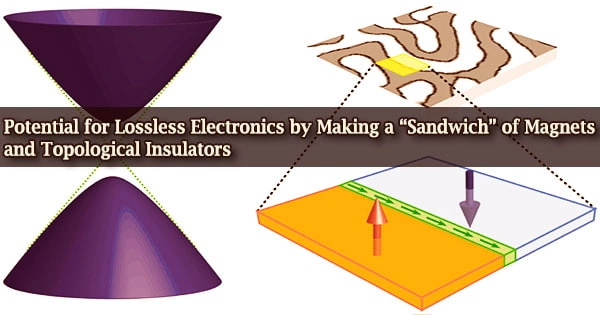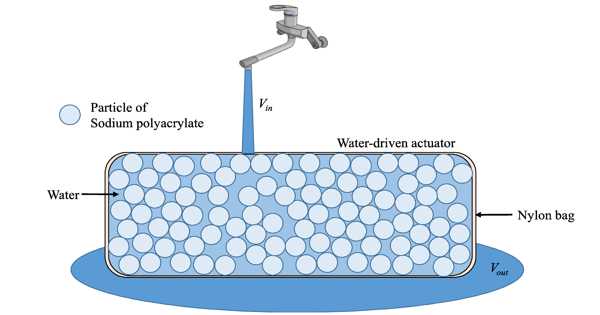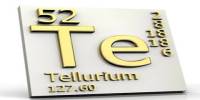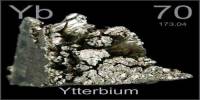A Monash University-led research team has revealed that a large-bandgap quantum anomalous Hall insulator can be created by sandwiching an ultrathin topological insulator between two 2D ferromagnetic insulators.
This type of heterostructure opens the door to ultra-low-energy future electronics and even topological photovoltaics.
Topological Insulator: The Filling in the Sandwich
A ferromagnetic material serves as the ‘bread’ of the sandwich in the researchers’ new heterostructure, while a topological insulator (i.e., a material with nontrivial topology) serves as the ‘filling.’
Quantum anomalous Hall (QAH) insulators, as well as exotic quantum phases like the QAH effect, where current flows without dissipation through quantized edge states, are created by combining magnetism with nontrivial band topology.
To achieve the QAH effect at higher temperatures (approaching or exceeding room temperature) for lossless transport applications, inducing magnetic order in topological insulators by proximity to a magnetic material is a viable technique.
A sandwich construction with two single layers of MnBi2Te4 (a 2D ferromagnetic insulator) on either side of ultra-thin Bi2Te3 in the middle (a topological insulator)is one possible architecture. This arrangement should produce a strong QAH insulator phase with a bandgap substantially above the thermal energy available at ambient temperature (25 meV), according to calculations.
The new Monash-led study used molecular beam epitaxy to construct a MnBi2Te4 / Bi2Te3 /MnBi2Te4 heterostructure and angle-resolved photoelectron spectroscopy to examine the structure’s electrical structure.
“We observed strong, hexagonally-warped massive Dirac fermions and a bandgap of 75 meV,” says lead author Monash Ph.D. candidate Qile Li.
The magnetic origin of the gap was confirmed by the bandgap disappearing at the Curie temperature, as well as broken time-reversal symmetry and the exchange-Rashba effect, all of which were in excellent accord with density functional theory calculations.
“These findings provide insights into magnetic proximity effects in topological insulators, which will move lossless transport in topological insulators towards higher temperature,” says Monash group leader and lead author Dr. Mark Edmonds.
To minimize the interface potential when inducing magnetic order via proximity, we needed to find a 2D ferromagnet that possessed similar chemical and structural properties to the 3D topological insulator. This way, instead of an abrupt interface potential, there is a magnetic extension of the topological surface state into the magnetic layer. This strong interaction results in a significant exchange splitting in the topological surface state of the thin film and opens a large gap.
Qile Li
How It Works
The 2D MnBi2Te4 ferromagnets used magnetic closeness to produce magnetic order (i.e., an exchange interaction with the 2D Dirac electrons) in the ultra-thin topological insulator Bi2Te3.
The hetero structure then becomes a quantum anomalous Hall (QAH) insulator, causing the material to become metallic (i.e., electrically conducting) along its one-dimensional borders while remaining electrically insulating in its center.
The QAH insulator’s nearly-zero resistance along the 1D edges is what makes it such a viable path to next-generation, low-energy devices. To date, numerous methods for achieving the QAH effect have been used, including injecting dilute amounts of magnetic dopants into ultrathin films of 3D topological insulators.
However, putting magnetic dopants into the crystal lattice is difficult and causes magnetic disorder, which lowers the temperature at which the QAH effect can be seen and limits future applications.
Rather of introducing 3D transition metals into the crystal lattice, placing two ferromagnetic materials on the top and bottom surfaces of a 3D topological insulator is a more favorable technique.
This breaks time-reversal symmetry in the topological insulator with magnetic order, resulting in the opening of a bandgap in the topological insulator’s surface state and the formation of a QAH insulator.
Making the Right Kind of Sandwich
However, due to the unwanted influence of the abrupt interface potential that emerges due to lattice mismatch between the magnetic materials and the topological insulator, creating sufficient magnetic order to open a large gap by magnetic proximity effects is difficult.
“To minimize the interface potential when inducing magnetic order via proximity, we needed to find a 2D ferromagnet that possessed similar chemical and structural properties to the 3D topological insulator,” says Qile Li, who is also a PhD student with the Australian Research Council Centre for Excellence in Future Low-Energy Electronic Technologies (FLEET).
“This way, instead of an abrupt interface potential, there is a magnetic extension of the topological surface state into the magnetic layer. This strong interaction results in a significant exchange splitting in the topological surface state of the thin film and opens a large gap,” says Li.
Because it is a ferromagnetic insulator with a Curie temperature of 20 K, a single septuple layer of the intrinsic magnetic topological insulator MnBi2Te4 is very intriguing.
“More importantly, this setup is structurally very similar to the well-known 3D topological insulator Bi2Te3, with a lattice mismatch of only 1%,” says Dr. Mark Edmonds, who is an associate investigator in FLEET.
In collaboration with beamline staff scientist Dr. Sung-Kwan Mo, the research team traveled to the Advanced Light Source at the Lawrence Berkeley National Laboratory in Berkeley, California, where they grew the ferromagnet/topological/ferromagnet heterostructures and investigated their electronic bandstructure.
“Although we cannot directly observe the QAH effect using angle-resolved photoemission spectroscopy (ARPES), we could use this technique to probe the size of the bandgap opening, and then confirm it is magnetic in origin,” says Dr. Edmonds.
“By using angle-resolved photoemission we could also probe the hexagonal warping in the surface state. It turns out, the strength of the warping in the Dirac fermions in our heterostructure is almost twice as large as in Bi2Te3,” says Dr. Edmonds
By combining experimental ARPES observations with magnetic measurements to determine the Curie temperature (performed by FLEET associate investigator Dr. David Cortie at the University of Wollongong) and first-principles density functional theory calculations performed by the group of physicists, the research team was able to confirm the electronic structure, gap size, and temperature at which this MnBi2Te4/Bi2Te3/MnBi2Te4 heterostructure is likely to support the QHE (Singapore University of Technology and Design).
The Australian Research Council’s Centres of Excellence and DECRA Fellowship programs sponsored the research, while the Australian Synchrotron funded the trip to Berkeley.
















